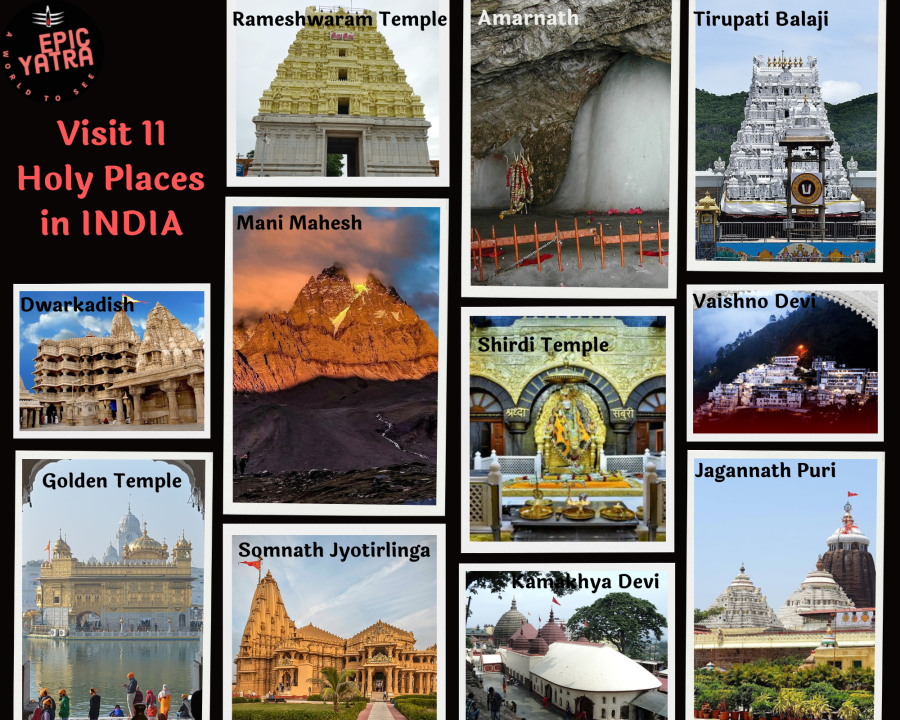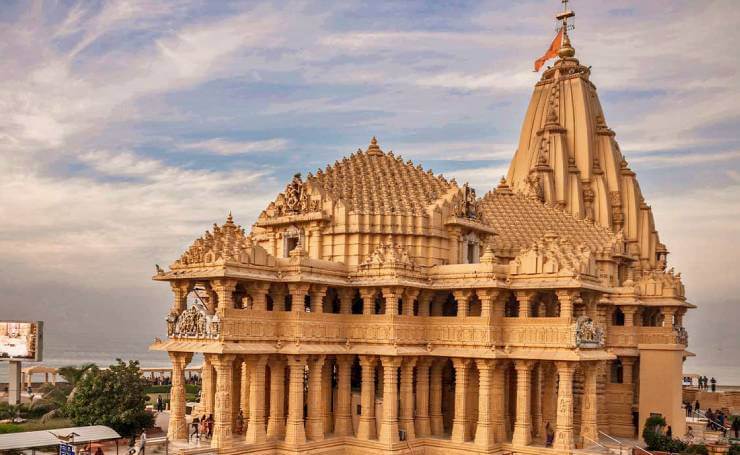The 12 Jyotirlingas in India are sacred sites dedicated to Lord Shiva. These are located across different states, each with unique significance.
India’s 12 Jyotirlingas are some of the most revered pilgrimage destinations for devotees of Lord Shiva. Each Jyotirlinga represents a different manifestation of Shiva, and visiting these sacred sites is believed to absolve sins and grant blessings. The Jyotirlingas are spread across various states, offering a spiritual journey through India’s diverse landscapes.
These holy shrines include Somnath in Gujarat, Mallikarjuna in Andhra Pradesh, and Mahakaleshwar in Madhya Pradesh, among others. Pilgrims from all over the world visit these temples to seek divine intervention and spiritual growth. Visiting these holy sites is an enriching experience, blending devotion with cultural exploration.
Introduction To The 12 Jyotirlingas
The 12 Jyotirlingas are sacred sites dedicated to Lord Shiva. These sites hold immense spiritual significance for Hindus. Each Jyotirlinga represents a unique manifestation of Shiva. They are spread across various locations in India. Pilgrims visit these holy shrines to seek blessings and attain spiritual enlightenment.
Significance In Hindu Mythology
In Hindu mythology, the Jyotirlingas are believed to be places where Lord Shiva appeared as a fiery column of light. The term “Jyotirlinga” means “pillar of light”. These sites are considered powerful symbols of Shiva’s divine energy. Each Jyotirlinga has its own unique legend and significance. They are mentioned in ancient texts like the Shiva Purana and the Linga Purana.
Pilgrimage And Spirituality
Visiting the Jyotirlingas is a profound spiritual journey for devotees. Pilgrims undertake this journey to seek inner peace and divine blessings. Each Jyotirlinga temple is distinct in its architecture and rituals. Devotees believe that visiting all 12 Jyotirlingas can cleanse one’s soul. The pilgrimage is not just a physical journey but a spiritual quest for enlightenment.
| Jyotirlinga | Location | State |
|---|---|---|
| Somnath | Prabhas Patan | Gujarat |
| Mallikarjuna | Srisailam | Andhra Pradesh |
| Mahakaleshwar | Ujjain | Madhya Pradesh |
| Omkareshwar | Khandwa | Madhya Pradesh |
| Kedarnath | Kedarnath | Uttarakhand |
| Bhimashankar | Pune | Maharashtra |
| Kashi Vishwanath | Varanasi | Uttar Pradesh |
| Trimbakeshwar | Nashik | Maharashtra |
| Vaidyanath | Deoghar | Jharkhand |
| Nageshwar | Dwarka | Gujarat |
| Ramanathaswamy | Rameswaram | Tamil Nadu |
| Grishneshwar | Ellora | Maharashtra |

The Legend Behind Jyotirlingas
The 12 Jyotirlingas are sacred shrines dedicated to Lord Shiva. These holy sites are spread across India. Each Jyotirlinga represents a unique manifestation of Shiva. The legend behind these sacred shrines is fascinating and mystical.
Shiva’s Cosmic Light
According to Hindu mythology, Shiva’s Cosmic Light is the essence of the Jyotirlingas. These shrines are believed to house the radiant light of Lord Shiva. This divine light symbolizes his infinite power and presence.
The Story Of The Pillar Of Light
The story of the Pillar of Light is a well-known legend. It begins with a dispute between Lord Vishnu and Lord Brahma. They argued over who was the supreme deity. To settle this, Lord Shiva appeared as a massive pillar of light.
Both Vishnu and Brahma set out to find the ends of this pillar. Vishnu transformed into a boar and dug deep into the earth. Brahma took the form of a swan and flew towards the sky. Neither could find the end of the light pillar.
This story highlights Shiva’s limitless form. It showcases his eternal and infinite nature. These sacred sites are thus considered a testament to Shiva’s divine presence. Each Jyotirlinga is a part of this cosmic light.
| Jyotirlinga | Location |
|---|---|
| Somnath | Gujarat |
| Mallikarjuna | Andhra Pradesh |
| Mahakaleshwar | Madhya Pradesh |
| Omkareshwar | Madhya Pradesh |
| Kedarnath | Uttarakhand |
| Bhimashankar | Maharashtra |
| Kashi Vishwanath | Uttar Pradesh |
| Trimbakeshwar | Maharashtra |
| Vaidyanath | Jharkhand |
| Nageshwar | Gujarat |
| Ramanathaswamy | Tamil Nadu |
| Grishneshwar | Maharashtra |
Mapping The Sacred: Locations Across India
India is home to the 12 Jyotirlingas, the most revered shrines dedicated to Lord Shiva. These sacred sites are spread across the country, each carrying its unique significance. Understanding their geographical spread and cultural ties helps in appreciating their importance.
Geographical Spread
The 12 Jyotirlingas are scattered across various states in India. This distribution emphasizes their widespread spiritual significance. Here is a list of these sacred sites and their locations:
| Jyotirlinga | Location | State |
|---|---|---|
| Somnath | Prabhas Patan | Gujarat |
| Mallikarjuna | Srisailam | Andhra Pradesh |
| Mahakaleshwar | Ujjain | Madhya Pradesh |
| Omkareshwar | Madhya Pradesh | Madhya Pradesh |
| Kedarnath | Kedarnath | Uttarakhand |
| Bhimashankar | Pune | Maharashtra |
| Kashi Vishwanath | Varanasi | Uttar Pradesh |
| Trimbakeshwar | Nashik | Maharashtra |
| Vaidyanath | Deoghar | Jharkhand |
| Nageshwar | Dwarka | Gujarat |
| Ramanathaswamy | Rameswaram | Tamil Nadu |
| Grishneshwar | Aurangabad | Maharashtra |
Cultural Ties To Regions
Each Jyotirlinga is deeply rooted in the culture of its region. Their legends and rituals are integral to local traditions. Here are some highlights:
- Somnath in Gujarat is believed to be the first of the 12 Jyotirlingas. It attracts millions of pilgrims annually.
- Kashi Vishwanath in Uttar Pradesh is situated in Varanasi, one of the oldest cities in the world. It is a major pilgrimage center.
- Kedarnath in Uttarakhand is part of the Char Dham pilgrimage circuit.
- Ramanathaswamy in Tamil Nadu is located on Rameswaram island. It is closely associated with the epic Ramayana.
- Mahakaleshwar in Madhya Pradesh is known for its unique Bhasma Aarti ritual.
The 12 Jyotirlingas not only represent the divine presence of Lord Shiva but also embody the rich cultural heritage of India.
Somnath: The Revered Beginning
The Somnath Temple holds a special place among the 12 Jyotirlingas. This sacred site is located in Prabhas Patan, near Veraval in Saurashtra, Gujarat. It is considered the first of the twelve Jyotirlingas of Lord Shiva. The Somnath Temple has a rich history and architectural grandeur that attracts millions of devotees and tourists.
Historical Attacks And Reconstruction
The Somnath Temple has faced numerous attacks throughout history. It was first destroyed by Mahmud of Ghazni in 1024 AD. Over the centuries, it was attacked and rebuilt multiple times. The temple was plundered by various invaders, including Allauddin Khilji and Aurangzeb. Despite these destructions, the temple was always rebuilt by the faithful.
The modern reconstruction of the temple was initiated by Sardar Vallabhbhai Patel in 1951. The temple today stands as a symbol of resilience and faith. It was rebuilt in the Chalukya style of architecture, designed by the renowned architect Prabhashankar Sompura.
Architectural Marvel
The Somnath Temple is an architectural masterpiece. It features intricate carvings and a majestic spire that reaches a height of 155 feet. The temple’s main shikhara, or tower, is adorned with beautiful sculptures and carvings.
Inside, the sanctum houses the sacred Jyotirlinga of Lord Shiva. The temple complex also includes a large courtyard, a Sabha Mandap (assembly hall), and a Nritya Mandap (dancing hall). The architecture reflects the rich heritage and artistic excellence of ancient India.
The temple’s location by the Arabian Sea adds to its spiritual ambiance. The sound of the waves and the sight of the temple against the backdrop of the sea create a serene and divine atmosphere. The Somnath Temple is not just a place of worship, but a testament to the enduring spirit of devotion and architectural brilliance.
Mallikarjuna: The Mountain Shrine
Mallikarjuna, one of the 12 Jyotirlingas, is a sacred site dedicated to Lord Shiva. Nestled in the Nallamala Hills in Andhra Pradesh, this temple is a beacon of spiritual significance. Pilgrims from across India visit this holy shrine, seeking divine blessings and solace.
Srisailam’s Natural Beauty
Srisailam is not just a religious center; it is also known for its breathtaking natural beauty. The temple is surrounded by lush green forests, offering a serene atmosphere. The Krishna River flows nearby, adding to the picturesque landscape. Visitors can enjoy the scenic views while embarking on their spiritual journey.
The area is rich in biodiversity, making it a haven for nature lovers. Wildlife enthusiasts can spot various species of flora and fauna. The combination of spiritual and natural beauty makes Srisailam a unique destination.
Festivals And Rituals
The Mallikarjuna Temple is a hub of festive activities throughout the year. One of the most celebrated festivals is Maha Shivaratri, which attracts thousands of devotees. During this festival, special pujas and rituals are performed in honor of Lord Shiva.
Daily rituals include Abhishekam, Alankaram, and Aarti. These rituals are performed with great devotion and are a sight to behold. Devotees participate in these rituals, seeking blessings and peace.
| Festival | Month | Significance |
|---|---|---|
| Maha Shivaratri | February/March | Night-long vigil and worship |
| Karthika Masam | November | Special prayers and rituals |
| Ugadi | April | New Year festival |
Visiting Mallikarjuna during these festivals offers a unique spiritual experience. The temple’s ambiance during these times is filled with energy and devotion. Pilgrims find solace in participating in these age-old traditions.
Mahakaleshwar: The Timekeeper Of The Universe
Mahakaleshwar Jyotirlinga is one of the most revered shrines dedicated to Lord Shiva. This sacred site is located in Ujjain, Madhya Pradesh. Mahakaleshwar means the ‘Lord of Time,’ representing Shiva as the ruler of time and death. The temple is known for its unique rituals and architectural beauty. It attracts thousands of devotees and tourists every year.
The Unique South-facing Idol
One unique feature of the Mahakaleshwar temple is its south-facing idol. Most Shiva temples have north or east-facing idols. Mahakaleshwar’s idol faces south, symbolizing the destruction of evil and negative energies. This south-facing aspect is rare and adds to the temple’s mystique.
The idol is also known for its intricate carvings and design. The temple’s sanctum sanctorum is adorned with beautiful sculptures. These depict various forms of Lord Shiva, enhancing the spiritual ambiance.
The Bhasma Aarti
The Bhasma Aarti is one of the most significant rituals at Mahakaleshwar. This unique ritual involves offering sacred ash to the deity. The ash used is from burnt cow dung, symbolizing purity and devotion. The Bhasma Aarti takes place every morning before sunrise. Devotees believe that witnessing this aarti brings immense blessings and spiritual upliftment.
During the aarti, priests perform elaborate rituals accompanied by chanting and music. The entire atmosphere becomes charged with divine energy. The aarti is a visual and spiritual treat for devotees and visitors alike.
| Feature | Description |
|---|---|
| Location | Ujjain, Madhya Pradesh |
| Unique Aspect | South-Facing Idol |
| Special Ritual | Bhasma Aarti |
Mahakaleshwar Jyotirlinga is a must-visit for anyone seeking spiritual solace. The temple’s unique features and rituals make it a significant pilgrimage site. Visiting Mahakaleshwar offers a chance to experience the divine presence of Lord Shiva.
Omkareshwar: The Island Shaped Like Om
Omkareshwar is one of the twelve revered Jyotirlingas. Located on an island in the Narmada River, this site is unique. The island is naturally shaped like the sacred symbol “Om”. This special shape makes it a significant pilgrimage destination for devotees of Lord Shiva.
Confluence Of Rivers
The holy island of Omkareshwar is at the confluence of the Narmada and Kaveri rivers. This meeting point of two sacred rivers adds to the spiritual significance. Pilgrims believe that taking a dip here washes away sins.
Both rivers surround the island, giving it a serene and divine atmosphere. The sound of flowing water creates a peaceful environment for meditation and worship.
Pilgrimage Practices
Devotees visit Omkareshwar to perform various religious rituals. The main temple, Omkareshwar Mandir, houses one of the twelve Jyotirlingas. Pilgrims offer prayers, flowers, and milk to the deity.
Another important ritual is the Parikrama or circumambulation of the island. Pilgrims walk around the island, chanting holy mantras. This practice is believed to bring divine blessings.
The island also hosts the Mamleshwar Temple, another ancient shrine dedicated to Lord Shiva. Many pilgrims visit both temples during their pilgrimage.
| Temple Name | Significance |
|---|---|
| Omkareshwar Mandir | One of the twelve Jyotirlingas |
| Mamleshwar Temple | Ancient shrine |
The island of Omkareshwar is also known for its scenic beauty. The lush green surroundings and the tranquil river enhance the spiritual experience.
Kedarnath: Amidst The Snow-capped Peaks
Among the 12 Jyotirlingas, Kedarnath holds a unique charm. Nestled in the Himalayas, this sacred site is a beacon for devotees of Lord Shiva. The temple is surrounded by breathtaking snow-capped peaks. Every year, thousands embark on a journey to seek blessings from the Lord of Kedarnath.
Impact Of Natural Disasters
The region has faced significant challenges due to natural disasters. In 2013, a devastating flood struck Kedarnath. The flood caused massive destruction. Yet, the temple remarkably remained intact. This event tested the resilience and faith of devotees. Despite the tragedy, people continue to flock to Kedarnath. The government has since improved infrastructure to ensure safety.
The Challenging Trek
Reaching Kedarnath requires a challenging trek. The journey begins at Gaurikund. From there, it’s a 16 km trek to the temple. The path is steep and rugged. Trekkers often face harsh weather conditions. Yet, the scenic beauty and spiritual significance make it worthwhile. Many pilgrims chant hymns and sing praises of Lord Shiva along the way. This trek is a test of endurance and devotion.
| Distance | 16 km |
|---|---|
| Starting Point | Gaurikund |
| Elevation | 3,583 meters |
- Carry warm clothes due to the cold climate.
- Start early to avoid afternoon rains.
- Stay hydrated and take breaks during the trek.
Kedarnath remains a symbol of faith and resilience. Despite challenges, the spirit of devotion never wavers. The journey itself is a testament to the enduring faith in Lord Shiva.
Bhimashankar: In The Dense Forests Of The Western Ghats
The Bhimashankar Temple is nestled in the lush forests of the Western Ghats. It is one of the twelve sacred Jyotirlingas of Lord Shiva. This temple is a blend of natural beauty and spiritual significance. Pilgrims and nature lovers visit this serene place for peace and blessings.
Wildlife Sanctuary
The Bhimashankar Temple is located within the Bhimashankar Wildlife Sanctuary. This sanctuary is home to many rare and endangered species. The Indian Giant Squirrel, also known as Shekru, is a highlight here. Dense forests and rich biodiversity make this sanctuary a haven for wildlife enthusiasts.
The sanctuary covers an area of about 120 square kilometers. It is part of the Western Ghats, a UNESCO World Heritage Site. The lush greenery and cool climate attract many visitors year-round.
Local Legends
Many local legends surround the Bhimashankar Temple. One popular story involves Lord Shiva and the demon Bhima. According to the legend, Bhima terrorized the region. Lord Shiva appeared to defeat him, and the spot where he emerged is now the temple.
Another legend links Bhimashankar to the story of Shiva and Parvati. It is believed that Shiva took the form of Bhimashankar to protect his devotees. These legends add a mystical charm to the temple’s history.
Visiting Bhimashankar offers more than just spiritual enlightenment. The natural beauty and fascinating legends create a unique experience. This sacred site is a must-visit for anyone seeking peace and adventure.
Kashi Vishwanath: The Eternal City Of Varanasi
Located in the vibrant city of Varanasi, the Kashi Vishwanath Temple stands as one of the most revered Jyotirlingas. This ancient temple dedicated to Lord Shiva attracts millions of devotees every year. It’s not just a place of worship but a spiritual experience that connects individuals to the divine.
Spiritual Center Of The World
Varanasi, also known as Kashi, is considered the spiritual center of the world. The Kashi Vishwanath Temple holds immense significance in Hinduism. It is believed that visiting this temple washes away one’s sins and grants liberation (Moksha). The temple’s architecture is a testament to ancient Indian craftsmanship, with intricate carvings and a golden spire that captures the essence of divinity.
Ganga Aarti And Rituals
The Ganga Aarti at Varanasi is a mesmerizing ritual that takes place every evening on the banks of the Ganges. Devotees gather to witness the ceremonial worship of the river, where priests perform Aarti with large lamps. The sight of the illuminated lamps against the backdrop of the river is spellbinding.
The rituals at Kashi Vishwanath Temple include daily prayers, Abhishekam (ritual bathing of the deity), and chanting of Vedic hymns. These rituals create an atmosphere filled with divine energy and devotion.
| Ritual | Time | Description |
|---|---|---|
| Morning Aarti | 3:00 AM | Early morning prayers and Abhishekam |
| Ganga Aarti | 6:00 PM | Evening worship on the riverbank |
| Evening Aarti | 7:00 PM | Evening prayers and lamp offering |
Visiting Kashi Vishwanath Temple during the Ganga Aarti is a must for spiritual seekers. The vibrant energy and devotion felt during these rituals are unparalleled. This sacred site not only offers a spiritual journey but also a cultural experience that stays with you forever.
Trimbakeshwar: By The Godavari River
The Trimbakeshwar Temple is one of the 12 Jyotirlingas in India. It is located in the town of Trimbak, Maharashtra. The temple sits by the sacred Godavari River. This site holds immense spiritual significance for devotees of Lord Shiva. The serene environment and the divine aura make it a must-visit for pilgrims.
Source Of The Godavari
The Godavari River originates from the Brahmagiri Hills near Trimbakeshwar. This river is one of the longest rivers in India. It is often referred to as the Dakshin Ganga or the Ganges of the South. The source of the Godavari is a holy spot. Pilgrims believe that a dip in this river cleanses sins and purifies the soul.
| Location | Feature |
|---|---|
| Brahmagiri Hills | Source of the Godavari River |
Significance Of The Tri-sandhya Gayatri
The Tri-Sandhya Gayatri is a special prayer chanted at Trimbakeshwar. It is recited three times a day: at dawn, noon, and dusk. Devotees believe that chanting this prayer brings divine blessings. The prayer is dedicated to Lord Shiva and is considered very powerful.
- Dawn: Start your day with spiritual energy.
- Noon: Seek protection and strength.
- Dusk: End your day with peace and gratitude.
Trimbakeshwar’s spiritual ambience attracts thousands of devotees every year. The temple’s rituals and serene setting make it a unique Jyotirlinga site.
Vaidyanath: The Healer Of Ailments
Among the 12 Jyotirlingas in India, Vaidyanath holds a special place. It is known as the Healer of Ailments. Devotees believe that Lord Shiva, in this form, cures all diseases. Located in Deoghar, Jharkhand, this sacred site attracts thousands of pilgrims each year.
Connection To Ravana
Vaidyanath Jyotirlinga has a strong connection to the demon king Ravana. According to legends, Ravana worshipped Lord Shiva to gain immense power. He performed severe penance and offered his ten heads to Lord Shiva. Impressed by his devotion, Lord Shiva appeared and healed Ravana’s wounds. Thus, the name Vaidyanath, meaning ‘Lord of Physicians,’ was given.
The Shakti Peeth Link
Vaidyanath is not just a Jyotirlinga; it is also a Shakti Peeth. Shakti Peeths are sacred sites dedicated to Goddess Shakti. The temple complex houses the shrine of Parvati, Shiva’s consort. This dual significance makes Vaidyanath a unique and powerful spiritual destination.
Here’s a quick overview of Vaidyanath’s significance:
- Location: Deoghar, Jharkhand
- Speciality: Healer of ailments
- Connection: Ravana’s devotion
- Additional Importance: Shakti Peeth
Visiting Vaidyanath offers spiritual healing and a deeper connection to Lord Shiva and Goddess Shakti.
Nageshwar: Where Shiva Defeated Daruka
Nageshwar Jyotirlinga stands as a symbol of Lord Shiva’s power and benevolence. Located in Dwarka, Gujarat, this sacred site marks the spot where Shiva triumphed over the demon Daruka. The temple attracts devotees from around the world, seeking blessings and divine intervention.
The Giant Statue Of Shiva
One of the most striking features of the Nageshwar temple is the giant statue of Lord Shiva. This imposing figure, standing at 82 feet, is visible from a great distance and welcomes pilgrims with its awe-inspiring presence. The statue represents Shiva in a meditative pose, symbolizing peace and power.
Pilgrims often marvel at the statue’s intricate details. The serene expression on Shiva’s face instills a sense of calm and reverence. Surrounding the statue, lush gardens and tranquil spaces offer a perfect setting for reflection and prayer.
Mythological Importance
According to legend, the demon Daruka terrorized the region around Dwarka. The locals, desperate for relief, prayed to Lord Shiva. Answering their prayers, Shiva descended and vanquished Daruka, restoring peace. The spot where this epic battle occurred became the site of the Nageshwar Jyotirlinga.
This sacred event is commemorated by the temple, which serves as a reminder of Shiva’s protective nature. Devotees believe that visiting Nageshwar can help them overcome their own battles and challenges. The temple’s spiritual significance is deeply rooted in these ancient tales of divine intervention.


Rameshwaram: The Southernmost Pilgrimage
Rameshwaram is a sacred town in Tamil Nadu. It is known for its Ramanathaswamy Temple. This temple is one of the twelve Jyotirlingas of Lord Shiva. Pilgrims from all over India visit this holy place. The town is on Pamban Island, connected to the mainland by a bridge.
The Ramanathaswamy Temple
The Ramanathaswamy Temple is the main attraction in Rameshwaram. It has the longest corridor among all Hindu temples. The temple’s architecture is stunning. The high pillars and intricate designs are a treat for the eyes. Devotees come here to worship Lord Shiva.
The temple has a unique feature. It houses two lingams. One is the Ramalingam, installed by Lord Rama. The other is the Vishwalingam, brought by Hanuman from Kailash. Devotees must worship Vishwalingam first, as per Lord Rama’s instructions.
The Sethu Karai Connection
Sethu Karai is a place near Rameshwaram. It is believed to be the starting point of the Ram Setu. This bridge was built by Lord Rama’s army to reach Lanka. The place holds great significance in the Ramayana.
Pilgrims visit Sethu Karai to take a holy dip. It is believed to wash away sins. The spot offers a serene atmosphere. The view of the sea and the distant horizon is mesmerizing.
| Jyotirlinga | Location |
|---|---|
| Ramanathaswamy | Rameshwaram, Tamil Nadu |
Visiting Rameshwaram is a spiritual experience. The town’s rich heritage and sacred sites leave a lasting impression. It is a must-visit for every devotee of Lord Shiva.
Grishneshwar: The Abode Of Compassion
Grishneshwar is one of the 12 Jyotirlingas in India. It is a sacred site devoted to Lord Shiva. This temple is a symbol of divine compassion and grace. Located in Maharashtra, it attracts countless devotees each year.
Ellora Caves Proximity
One of the unique features of Grishneshwar is its proximity to the Ellora Caves. The caves are a UNESCO World Heritage Site. They are just a short distance away from the temple. This makes it a perfect destination for both spiritual and historical exploration.
| Feature | Details |
|---|---|
| Location | Aurangabad, Maharashtra |
| Distance from Ellora Caves | About 1 km |
Visitors can enjoy the spiritual aura of the temple. They can also explore the rich history of the Ellora Caves. This makes their trip both enriching and fulfilling.
Architectural Splendor
The architectural splendor of Grishneshwar Temple is truly mesmerizing. The temple showcases intricate carvings and sculptures. These reflect the rich cultural heritage of ancient India.
- The temple is built in the Hemadpanthi style.
- The red volcanic basalt stone adds to its unique look.
- The intricate carvings depict various stories from Hindu mythology.
Each corner of the temple tells a story. The carvings and sculptures showcase the craftsmanship of the era. The temple stands as a testament to the devotion and skill of ancient artisans.
The Pilgrimage Experience
Embarking on a pilgrimage to the 12 Jyotirlingas in India is a spiritual journey like no other. It is a path filled with devotion, reverence, and awe. Each of these sacred sites, dedicated to Lord Shiva, holds a unique charm and significance. Pilgrims from across the globe travel to these holy spots, seeking blessings and peace.
Yatra And Devotion
The journey, or Yatra, to the Jyotirlingas is an act of deep devotion and faith. Pilgrims often undertake this journey as a means to purify their soul and seek divine blessings. Each temple is a beacon of spiritual energy, drawing visitors into its serene and sacred atmosphere.
Let’s take a look at the names and locations of these 12 Jyotirlingas:
| Jyotirlinga | Location | State |
|---|---|---|
| Somnath | Prabhas Patan | Gujarat |
| Mallikarjuna | Srisailam | Andhra Pradesh |
| Mahakaleshwar | Ujjain | Madhya Pradesh |
| Omkareshwar | Khandwa | Madhya Pradesh |
| Kedarnath | Kedarnath | Uttarakhand |
| Bhimashankar | Pune | Maharashtra |
| Kashi Vishwanath | Varanasi | Uttar Pradesh |
| Trimbakeshwar | Nashik | Maharashtra |
| Vaidyanath | Deoghar | Jharkhand |
| Nageshwar | Dwarka | Gujarat |
| Ramanathaswamy | Rameswaram | Tamil Nadu |
| Grishneshwar | Ellora | Maharashtra |
Modern Challenges And Conservation
Modern challenges such as urbanization and pollution pose threats to these ancient sites. Conservation efforts are crucial to preserve their sanctity and historical significance. Local authorities and devotees often work together to maintain the cleanliness and integrity of these temples.
For instance, the Kashi Vishwanath Temple in Varanasi is undergoing major renovations to accommodate more pilgrims. Similarly, the Kedarnath Temple is being restored after the devastating floods. These efforts ensure that future generations can continue their spiritual journeys to these sacred sites.
Conclusion: The Journey Within
The journey to the 12 Jyotirlingas in India is not just a physical pilgrimage. It is a path to spiritual awakening and self-discovery. Each sacred site offers a unique experience that touches the soul.
Personal Transformation
Visiting these holy sites brings about deep personal transformation. Devotees often find a sense of peace and clarity. The energy at each Jyotirlinga helps in shedding negative thoughts.
Each temple has its own story and significance. This enriches one’s understanding of Hindu mythology. Many pilgrims report feeling closer to Lord Shiva after their visits. The spiritual atmosphere aids in meditation and self-reflection.
Preserving The Sanctity
Maintaining the sanctity of these sacred sites is crucial. Local authorities and devotees work together to keep the temples clean and serene. Proper rituals and offerings ensure the divine energy remains intact.
Respecting the customs and traditions is important. This includes following dress codes and maintaining silence in the temple premises. Such practices help preserve the sanctity for future generations.
Environmental conservation is also a key aspect. Efforts are made to keep the surroundings green and pollution-free. This enhances the spiritual experience for everyone who visits.
| Jyotirlinga | Location | State |
|---|---|---|
| Somnath | Prabhas Patan | Gujarat |
| Mallikarjuna | Srisailam | Andhra Pradesh |
| Mahakaleshwar | Ujjain | Madhya Pradesh |
| Omkareshwar | Khandwa | Madhya Pradesh |
| Kedarnath | Kedarnath | Uttarakhand |
| Bhimashankar | Pune | Maharashtra |
| Kashi Vishwanath | Varanasi | Uttar Pradesh |
| Trimbakeshwar | Nashik | Maharashtra |
| Vaidyanath | Deoghar | Jharkhand |
| Nageshwar | Dwarka | Gujarat |
| Ramanathaswamy | Rameswaram | Tamil Nadu |
| Grishneshwar | Ellora | Maharashtra |


Frequently Asked Questions
Where Are The 12 Jyotirlingas Of India?
The 12 Jyotirlingas of India are located in Somnath, Mallikarjuna, Mahakaleshwar, Omkareshwar, Kedarnath, Bhimashankar, Kashi Vishwanath, Trimbakeshwar, Vaidyanath, Nageshwar, Rameshwar, and Grishneshwar.
Which Jyotirlinga Is Most Powerful?
The most powerful Jyotirlinga is Kashi Vishwanath in Varanasi. It holds immense spiritual significance and attracts millions of devotees.
Which Is The First Jyotirlinga In India?
The first jyotirlinga in India is the Somnath Temple. It is located in Gujarat. This temple holds immense spiritual significance.
How Many Shiva Lingas Are There In India?
India has countless Shiva Lingas, with major ones in temples like Kashi Vishwanath, Somnath, and Kedarnath. The exact number remains unknown.
Conclusion
Visiting the 12 Jyotirlingas offers a profound spiritual journey across India. Each temple is unique and holds deep cultural significance. Exploring these sacred sites can provide a deeper connection to Lord Shiva. Plan your pilgrimage to experience the divine essence and timeless heritage of these revered locations.






